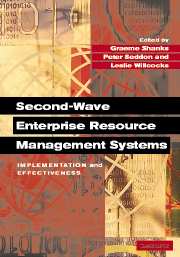Book contents
- Frontmatter
- Contents
- List of Contributors
- Introduction: ERP – The Quiet Revolution?
- Part I Implementation and Effectiveness: Overview
- Part II From Risks to Critical Success Factors
- Part III From Learning to Knowledge
- 10 Implementing Enterprise Resource Planning Systems: The Role of Learning from Failure
- 11 ERP Projects: Good or Bad for SMEs?
- 12 The Role of the CIO and IT Functions in ERP
- 13 Enterprise System Management with Reference Process Models
- 14 An ERP Implementation Case Study from a Knowledge Transfer Perspective
- 15 Knowledge Integration Processes within the Context of Enterprise Resource Planning System Implementation
- Part IV Cultural Aspects of Enterprise Systems
- Part V Future Directions
- Index
- References
14 - An ERP Implementation Case Study from a Knowledge Transfer Perspective
from Part III - From Learning to Knowledge
Published online by Cambridge University Press: 05 February 2012
- Frontmatter
- Contents
- List of Contributors
- Introduction: ERP – The Quiet Revolution?
- Part I Implementation and Effectiveness: Overview
- Part II From Risks to Critical Success Factors
- Part III From Learning to Knowledge
- 10 Implementing Enterprise Resource Planning Systems: The Role of Learning from Failure
- 11 ERP Projects: Good or Bad for SMEs?
- 12 The Role of the CIO and IT Functions in ERP
- 13 Enterprise System Management with Reference Process Models
- 14 An ERP Implementation Case Study from a Knowledge Transfer Perspective
- 15 Knowledge Integration Processes within the Context of Enterprise Resource Planning System Implementation
- Part IV Cultural Aspects of Enterprise Systems
- Part V Future Directions
- Index
- References
Summary
Introduction
Knowledge transfer is an important topic in management literature. Some studies have focused on the transfer of best business practices in multinational corporations as they transfer accumulated knowledge from their headquarters to new foreign affiliates (Ghoshal and Nohria, 1989; Gupta and Govindarajan, 1991; Kogut and Zander, 1993). Other studies have focused on the transfer of technology, business processes, and best practices inside a firm (for example, Argote, 1999). However, current studies have not focused on the unique knowledge transfer practices involved in an Enterprise Resource Planning (ERP) implementation.
ERP is an enterprise-wide application software package. In ERP, all necessary business functions, such as financial, manufacturing, human resources, distribution, and order management, are tightly integrated into a single system with a shared database. While customization is not impossible, the broad scope and close connectivity of all related functions make customization very costly (Davenport, 1998; Davis, 1998). The high cost and long implementation process of customization result in most organizations needing to align their business processes with the functionality provided by the ERP program rather than customizing the ERP package to match their current processes. According to Forrester Research, only 5% of organizations, among Fortune 1000 companies that had purchased an ERP application, customized it to match their business processes (Davis, 1998). Therefore, the implementation of ERP entails using the business models included in the package (Slater, 1998). In other words, business knowledge incorporated in the basic architecture of the software is transferred into the adopting organization.
- Type
- Chapter
- Information
- Second-Wave Enterprise Resource Planning SystemsImplementing for Effectiveness, pp. 335 - 350Publisher: Cambridge University PressPrint publication year: 2003

